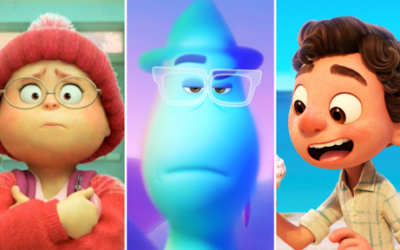Animation is frequently an expensive medium to create with; granted, film in general is typically quite costly, but to make an animated film, one where nearly everything has to be constructed from scratch, it’s far from uncommon for a filmmaker to spend the same amount of money that will often go into the average major blockbuster. This is perhaps one reason why, at least in North America, there aren’t too many animated features being made on a yearly basis; a studio can usually only afford to put out one or two animated films at a time, and there are only a small handful of animation studios currently operating (or at least there are only a few that stand a chance of making a respectable amount of money at the box office). Because of all this, most studios tend to spread out the releases of their animated offerings, with one not coming out until at least a few weeks after the previous, and when looking at the box office charts, there probably won’t be any more than two or three animated features sitting in the top 10. With that said, there are certainly exceptions to this rule, especially when independently made animated films, or even those made outside the United States, enter the scene and perform better than what is normally expected from them; such films have in fact become more common and popular over the past few years, and while they rarely rank especially high on the box office charts, their presence does nonetheless a noticeable rise in popularity that may be expanding past their niche demographics. Evidence of this trend can perhaps be easily found when looking at the results of the most recent weekend box office, specifically the period between Friday, October 11th, and Sunday, October 13th; for the first time in quite a while (if ever), there are currently five animated films to be found in the box office’s top 10, each of them coming across as fairly distinct from one another and showing that, as competitive as they may be, they’re still able to thrive in a market that isn’t always the easiest to contend with.
Granted, none of these films were able to make it to the top of the box office – that honor would ultimately go to the independent slasher film “Terrifier 3” (a remarkable achievement in its own right) – but that does little to diminish the impressiveness of these animated films and their ability to take up half of the Top 10. Even more impressive is how few of these features feel as if they’re targeted towards the exact same demographic; there may be some overlap, but they’re otherwise unique enough to appeal to different groups and thus benefit from catering more specifically to those groups. When looking at these five films, one will find that the collection is indeed rather diverse; some of them are new releases, while others are holdovers from the previous weeks (one is in fact a re-release of a film that’s over three decades old). Some are family-oriented, while others are aimed mostly at older audiences; some are made using computer animation, while others are hand-drawn or stop-motion. In short, there’s no one type of animated film that most audiences have been eager to direct their attention to, and all of them are better off because of it.
In terms of new releases, the Morgan Neville-directed LEGO-style documentary “Piece by Piece”, which tells the life story of popular musician Pharrell Williams, was easily the most successful of the bunch, just barely cracking the top 5 and earning a total of roughly $3.8 million over the three-day period. This amount may be lower than what distributor Focus Features was hoping for – early estimates suggested the film would earn somewhere between $5-7 million – but it nevertheless serves as the highest opening weekend for an animated documentary, and the film will easily be the most finanically successful of such films (which may explain why there are so few in existence) by the end of its run. Even if the film does ultimately fail to make back the costs put into it, “Piece by Piece” only had a budget of around $16 million, so it won’t be a huge loss to Focus Features, and if nothing else, the film should be able to get by off its generally positive reception from critics (with Rotten Tomatoes currently listing an 81% approval rating).
Just a few spots below at the #8 spot is Tensai Okamura’s anime feature “My Hero Academia: You’re Next”, the latest cinematic installment of the widely beloved “My Hero Academia” anime series. With a weekend total of around $3 million, this film’s grosses so far aren’t quite as high as some of its predecessors – 2020’s “My Hero Academia: Hero Rising” and 2021’s “My Hero Academia: World Heroes’ Mission” each made $5.8 million and $6.2 million respectively during their opening weekends, but this might be partially due to some behind-the-scenes shake-ups, as distribution rights for this series has transitioned from anime distributor Funimation to Toho, one of Japan’s most prominent film distributors. Their acquisition of the North American distribution rights to “My Hero Academia” comes as part of a new plan to expand its reach overseas, and if the results so far aren’t quite on part with prior achievements, Toho will likely do all that it can to ensure that success is accomplished in the long run.
Finally, the last “new” animated release of the weekend, Disney’s stop-motion classic “The Nightmare Before Christmas”, made it all the way to the #9 spot and earned a total of around $2.3 million. Re-releasing this Henry Sellick-directed feature has become something of a holiday tradition for Disney; the film was even brought back to theaters last year in celebration of its 30th anniversary, an event that ultimately added $9.8 million to its total gross. With this most recent re-release, “The Nightmare Before Christmas” has so far earned a lifetime total of $90 million, a good percentage of that coming from yearly re-releases. The film’s ability to keep audiences coming back to see it on the big screen, enough for Disney to keep putting it back into theaters on a regular basis, is perhaps a testament to the film’s long-term appeal.
All that remains of this weekend’s animated offerings are two holdovers from the weeks prior, with DreamWorks’ “The Wild Robot” performing the best out of all these films with a weekend total of $13.4 million and making it all the way to the #2 spot. Having only dropped 27% from the previous weekend (allowing it to outrank the previous #1 film, Warner Bros’ “Joker: Folie a Deux”), the universally acclaimed film has performed rather remarkably since its release at the end of September, and the company’s recent decision to announce a sequel proves that it’s quite confident that the film will become a highly beloved franchise not too dissimilar from the likes of “Shrek” or “How to Train Your Dragon”. The other holdover, Paramount’s “Transformers One”, can meanwhile be found at #6 on the box office, having come out a week before “The Wild Robot” and adding $3.6 million in weekend grosses to a total that now sits at roughly $53 million. It’s a somewhat disappointing gross given the film’s $75 million budget, but reception from critics and audiences has also been immensely positive, so there’s hope that the film will still be able to form a dedicated following in the long run.
In fact, that seems to be the recurring theme among these animated films: few of them are doing as well at the box office as some might’ve desired, yet their artistic quality is high enough so that at least a small but devoted audience is willing to speak their praises. This should allow most of these animated features to maintain significant long-term value, but for the time being, the fact that they’re all able to sit alongside each other at the box office and take up half of its Top 10 should be enough cause for celebration. Animation has historically been dismissed as a kids-only medium that most adults aren’t willing to direct their attention towards, but that doesn’t entirely appear to be the case if this recent box office weekend is any proof. If animation can be just as abundant and prosperous at multiple points in the near future – in other words, if there can be this many animated films, each with its own distinct identity and target demographic, playing at once and not cannibalizing one another – then there may come a point where animation is just as admired and respected as its live-action counterpart.




